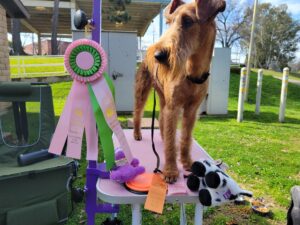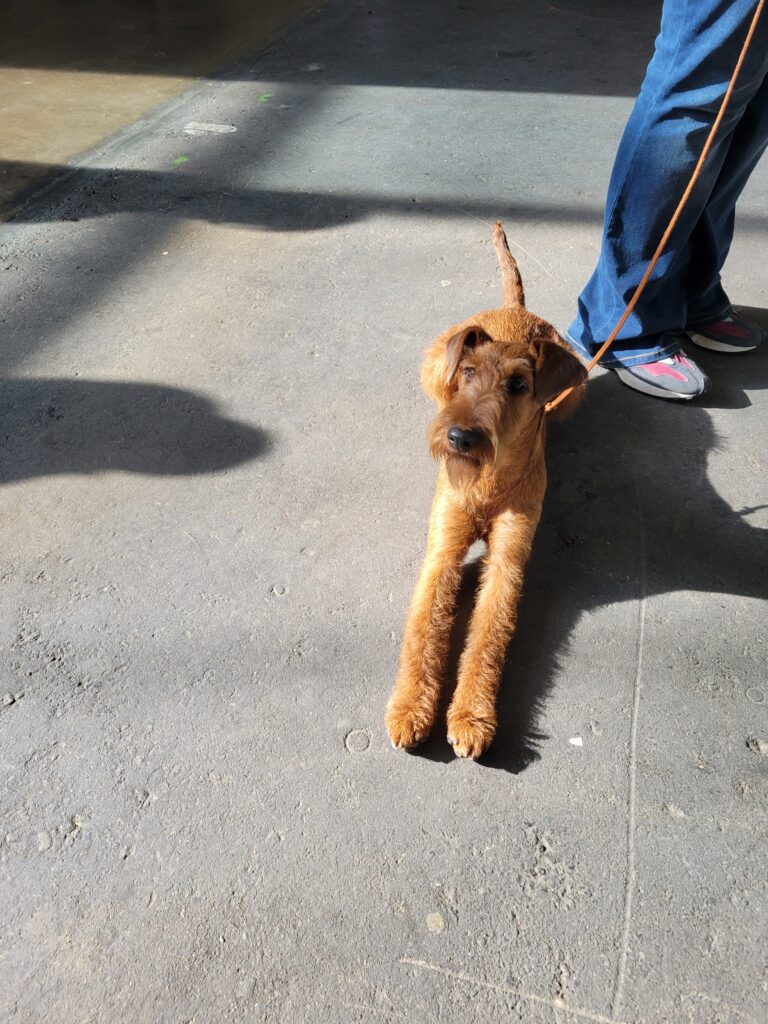
You have a dog and now you want to show it off. You’ve googled “dog shows.” You’ve watched the movie. You’ve seen the giant ribbons, the colorful dress suits, the fancy poodle cuts, and you’re ready to try your own hand at handling.
Welcome to the fabulous, if not slightly stressful world of dog conformation.
So where do you begin?
I will admit I’m far from an expert. I’ve been showing my own dog for a few months, mentored by some wonderful owners and owner handlers (I’ll explain the difference soon). We’ve already come home with a healthy supply of flat ribbons and spent a pretty penny on entries. Allow me to share my experience to help you through some of the stickier parts of beginner dog showing. I’m going to keep it simple and non-breed specific, and I’ll post updates along the way as I fumble my way through my newfound passion.
Here’s the shortlist:
- Get a dog.
- Determine who is going to handle your dog.
- Train your dog.
- Groom your dog.
- Sign up for shows.
- Go to a show,
- Find a place to display all your colorful ribbons.
Simple enough, right. Right. Okay, let’s get into some of the details.

Get A Dog
If you’ve never had a dog before, make sure you do your research before you dive in. I’m not going to tell you that you shouldn’t make your first dog a show dog, but your life might be a little less stressful if you go into it knowing what to expect from your crazy little (or big) cuddlebug. That said, not every dog is a show dog. For example, in order to show at an American Kennel Club (AKC) event, your dog must be registered as an accepted breed, and must remain intact for the duration of its show career. The latter part requires an owner to be knowledgeable and responsible about dog breeding, even if you never expect to breed your dog.
So where do you get a show dog if you don’t already have one?
If you live in the United States, start with the AKC website. There you will find links to articles and tools to help you explore the breeds that are right for you. Be honest with yourself about the expectations you have for your dog, the time commitment you’re willing to make, and the space you can provide. Remember, a dog, no matter what the breed, should be viewed as a lifelong commitment. Take your time on this. There will always be dogs looking for homes. You’ll want a good match for your lifestyle to ensure you’re providing a forever home for your new furry friend.
From there, look to the breed clubs to help you find a responsible, reputable breeder. Be wary of pet store puppies, cheap puppies, or breeders that have frequent litters by multiple bitches. In these cases there’s a high likelihood your dog is the product of a puppy mill. Many breeds have national clubs that can point you toward a breeder in your area. A Google search will give you options as well, but you will have to be extra cautious in vetting out a good breeder.
Be aware that most breeders won’t let you come to their house and pick a puppy. Many have applications of varying degrees that help them decide if they have a puppy that will meet your needs and expectations. Remember, they have known the puppies since birth, so they will have a good idea of what their character and show potential will be. Nevertheless, they should be willing to answer all of your questions as you pursue your dream dog. It’s also not uncommon to be placed on a waitlist. A reputable breeder with good lines may be in high demand, especially if you’re interested in a less common breed. If you don’t want to wait months or even years, you may choose to adjust your criteria a bit.
Choose A Handler
Now that you’ve spent an arm and a leg on the most beautiful, show quality puppy, things are about to get expensive. You have very little time to commit to showing your dog yourself, but you have deep pockets? Great, you can hire a professional handler. You can board your dog at your trainer’s kennel and let them handle everything.
The less expensive route is to become an Owner Handler. Learning to do it yourself will cost more time and energy on your part, but on the bright side, finding handling classes is fairly easy and they usually run about $15-20 per one-off class. As a newcomer, it will probably take you longer to title your dog than if a professional shows them, but you’ll have much more time to bond. Be patient with yourself and your pup, and practice often. If your breeder is local to your area, ask them for recommendations on handling classes. You would also do well to ask fellow owners of your breed. I have had success locating great handling classes by Google searching, on social media, and by word of mouth. An unexpected outcome of taking classes is that I’ve met a lot of Owner Handlers outside of my breed who have become a wonderful cheering section for me and my puppy, Saoirse.
If you choose to handle your own dog, remember to have fun with it. Don’t stress too much over low or no placings. You will likely have your share of those, just as you will probably be surprised at the number of wins you achieve.

Train Your Dog
Training your puppy is a great way to create a bond with them before you start showing. You can start with basic obedience once your puppy is vaccinated, even if it’s too young to show. You should have no trouble finding puppy classes that meet your needs. Many larger pet stores offer a variety of training options to get you started. There are also virtual options, or personalized training that you can find with a quick online search. You will want to build a good relationship with your puppy so it learns to respect you in the show ring. You will want to practice a strong “stand” command. Many classes teach dogs to “heel” which can lead to difficulties in the show ring when your dog thinks it needs to sit at your side whenever you stop. You can practice stacking your dog with a firm “stand” instead.
Familiarize yourself with your breed standard as you go into training. This will help you focus on enhancing and emphasizing the correctness of your dog as you learn to show. You can find your standards on the AKC website. Look at images of your breed properly stacked, and use a mirror when you practice. An instructor in a handling class will help you make the adjustments necessary to make your dog look as best as possible.
Don’t be afraid to experiment with training in other sports as well. Your dog may find conformation more enjoyable when he has something else to build his confidence. Think about what your dog was bred to do. You will find many sports that help focus his attention on his work. Agility, barn hunt, scent work, FastCAT, dock diving, and obedience are all good options to try.
Grooming for Show
Grooming your dog for a show can look like a lot of different things. Each breed has a different standard, expectation, and technique. Some dogs need extensive clippering and combing. Others should never be clippered, and instead might be hand stripped. For others, still, a regular comb through and a bath might suffice.
If your dog is with a professional handler, they will most likely take care of the grooming while he’s in their care. However, once you bring your dog home, you will have to decide on how you plan to maintain its coat. For a poodle, that could mean trims every six weeks or so. You might choose to administer some kind of control for shedding for a breed like labrador and that’s it. Breeds that don’t shed often have additional grooming requirements that help their coats stay healthy and in good condition.
Depending on your time commitment and breed, you may find that you can learn to groom your dog on your own. Find yourself a mentor, and you can learn to hand strip a wirehaired terrier, or do a little clippering on a toy breed. With enough time and patience you can even learn to properly trim a poodle. No matter what you choose, you will find that you accumulate an arsenal of combs, sprays, shampoos, stripping knives, clippers, and shears.
Seek out the company of someone who shows your breed. They can help you determine what tools you will need to groom your dog on the day of your show. Be sure to give yourself enough time to prepare your dog. You’ll probably start way too early at first, but you’ll develop a routine with time. A basic routine may consist of bathing, drying, combing and shaping, chalking, and spraying your dog’s coat before showtime. The time and effort depends on your breed’s coat and style. The standard for the breed you choose to own may dictate the amount of time you spend at a show on any given day, so keep that in mind as you research.

Sign Up and Go
You can search for shows in your area on the AKC website, or on another site called InfoDog.com. Social media is also a great place to get information as breed clubs often have pages where they post flyers and information. In less populated parts of the country you may have to travel to show venues. Be prepared for the added expense of hotels, airfare, or gas. You may also struggle to find shows with enough competition to earn points if your breed is rare or limited in your part of the country. You may find it more beneficial to save up for a few big shows than to travel a long way to small shows where you’re the only entry. However, you won’t know how many dogs will be in your class until after registration closes. The good news is entry fees are relatively low, usually in the $20-30 range.
Most shows release a premium in advance of the show that includes a paper form that you can submit by mail. You can also sign up online through AKC or on InfoDog. Don’t wait until the last minute, especially if you mail in your application. There is a strict cutoff for entries, and your events must be paid for before cutoff to be accepted.

Your first time in the ring can be stressful. Remember that what you’re feeling will translate down your leash to your dog. Follow along for details on how to handle your first time showing. In the meantime, enjoy the search for your new companion. Read books about your breed, watch videos, and start meeting breeders and handlers. It’s never too early to start some basic training.
We’ll see you in the ring.
